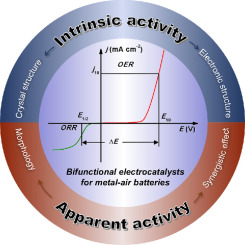当前位置:
X-MOL 学术
›
Chin. J. Catal.
›
论文详情
Our official English website, www.x-mol.net, welcomes your
feedback! (Note: you will need to create a separate account there.)
Micro-nanostructural designs of bifunctional electrocatalysts for metal-air batteries
Chinese Journal of Catalysis ( IF 15.7 ) Pub Date : 2020-03-01 , DOI: 10.1016/s1872-2067(19)63514-x Fang Shi , Xuefeng Zhu , Weishen Yang
Chinese Journal of Catalysis ( IF 15.7 ) Pub Date : 2020-03-01 , DOI: 10.1016/s1872-2067(19)63514-x Fang Shi , Xuefeng Zhu , Weishen Yang

|
Abstract Water-based rechargeable metal-air batteries play an important role in the storage and conversion of renewable electric energy. However, the sluggish kinetics of the oxygen reduction reaction (ORR) and oxygen evolution reaction (OER) have limited the practical application of rechargeable metal-air batteries. Most of reviews were focused on single functional electrocatalysts while few on bifunctional electrocatalysts. It is indispensable but challenging to design a bifunctional electrocatalyst that is active and stable to the two reactions. Recently, attempts to develop high active bifunctional electrocatalysts for both ORR and OER increase rapidly. Much work is focused on the micro-nano design of advanced structures to improve the performance of bifunctional electrocatalyst. Transition-metal materials, carbon materials and composite materials, and the methods developed to prepare micro-nano structures, such as electrochemical methods, chemical vapor deposition, hydrothermal methods and template methods are reported in literatures. Additionally, many strategies, such as adjustments of electronic structures, oxygen defects, metal-oxygen bonds, interfacial strain, nano composites, heteroatom doping etc., have been used extensively to design bifunctional electrocatalysts. To well understand the achievements in the recent literatures, this review focuses on the micro-nano structural design of materials, and the related methods and strategies are classed into two groups for the improvement of intrinsic and apparent activities. The fine adjustment of nano structures and an in-depth understanding of the reaction mechanism are also discussed briefly.
中文翻译:

金属-空气电池双功能电催化剂的微纳米结构设计
摘要 水基可充电金属空气电池在可再生电能的存储和转换中发挥着重要作用。然而,氧还原反应(ORR)和析氧反应(OER)缓慢的动力学限制了可充电金属-空气电池的实际应用。大多数评论都集中在单功能电催化剂上,而很少关注双功能电催化剂。设计一种对两种反应均具有活性且稳定的双功能电催化剂是必不可少但具有挑战性的。最近,开发用于 ORR 和 OER 的高活性双功能电催化剂的尝试迅速增加。许多工作都集中在先进结构的微纳米设计上,以提高双功能电催化剂的性能。过渡金属材料,碳材料和复合材料,以及制备微纳米结构的方法,如电化学法、化学气相沉积法、水热法和模板法等已有文献报道。此外,许多策略,如电子结构调整、氧缺陷、金属-氧键、界面应变、纳米复合材料、杂原子掺杂等,已被广泛用于设计双功能电催化剂。为了更好地理解最近文献中的成果,本综述重点关注材料的微纳米结构设计,并将相关方法和策略分为两组以提高内在和表观活性。还简要讨论了纳米结构的微调和对反应机理的深入理解。文献报道了电化学法、化学气相沉积法、水热法和模板法等制备微纳米结构的方法。此外,许多策略,如电子结构调整、氧缺陷、金属-氧键、界面应变、纳米复合材料、杂原子掺杂等,已被广泛用于设计双功能电催化剂。为了更好地理解最近文献中的成果,本综述重点关注材料的微纳米结构设计,并将相关方法和策略分为两组以提高内在和表观活性。还简要讨论了纳米结构的微调和对反应机理的深入理解。文献报道了电化学法、化学气相沉积法、水热法和模板法等制备微纳米结构的方法。此外,许多策略,如电子结构调整、氧缺陷、金属-氧键、界面应变、纳米复合材料、杂原子掺杂等,已被广泛用于设计双功能电催化剂。为了更好地理解最近文献中的成果,本综述重点关注材料的微纳米结构设计,并将相关方法和策略分为两组以提高内在和表观活性。还简要讨论了纳米结构的微调和对反应机理的深入理解。
更新日期:2020-03-01
中文翻译:

金属-空气电池双功能电催化剂的微纳米结构设计
摘要 水基可充电金属空气电池在可再生电能的存储和转换中发挥着重要作用。然而,氧还原反应(ORR)和析氧反应(OER)缓慢的动力学限制了可充电金属-空气电池的实际应用。大多数评论都集中在单功能电催化剂上,而很少关注双功能电催化剂。设计一种对两种反应均具有活性且稳定的双功能电催化剂是必不可少但具有挑战性的。最近,开发用于 ORR 和 OER 的高活性双功能电催化剂的尝试迅速增加。许多工作都集中在先进结构的微纳米设计上,以提高双功能电催化剂的性能。过渡金属材料,碳材料和复合材料,以及制备微纳米结构的方法,如电化学法、化学气相沉积法、水热法和模板法等已有文献报道。此外,许多策略,如电子结构调整、氧缺陷、金属-氧键、界面应变、纳米复合材料、杂原子掺杂等,已被广泛用于设计双功能电催化剂。为了更好地理解最近文献中的成果,本综述重点关注材料的微纳米结构设计,并将相关方法和策略分为两组以提高内在和表观活性。还简要讨论了纳米结构的微调和对反应机理的深入理解。文献报道了电化学法、化学气相沉积法、水热法和模板法等制备微纳米结构的方法。此外,许多策略,如电子结构调整、氧缺陷、金属-氧键、界面应变、纳米复合材料、杂原子掺杂等,已被广泛用于设计双功能电催化剂。为了更好地理解最近文献中的成果,本综述重点关注材料的微纳米结构设计,并将相关方法和策略分为两组以提高内在和表观活性。还简要讨论了纳米结构的微调和对反应机理的深入理解。文献报道了电化学法、化学气相沉积法、水热法和模板法等制备微纳米结构的方法。此外,许多策略,如电子结构调整、氧缺陷、金属-氧键、界面应变、纳米复合材料、杂原子掺杂等,已被广泛用于设计双功能电催化剂。为了更好地理解最近文献中的成果,本综述重点关注材料的微纳米结构设计,并将相关方法和策略分为两组以提高内在和表观活性。还简要讨论了纳米结构的微调和对反应机理的深入理解。











































 京公网安备 11010802027423号
京公网安备 11010802027423号